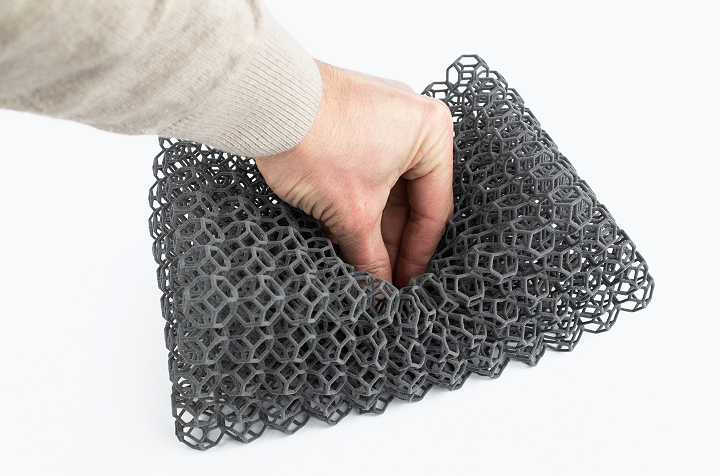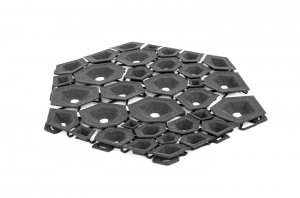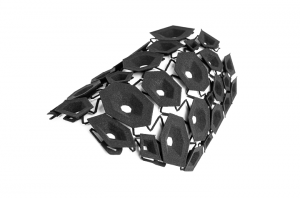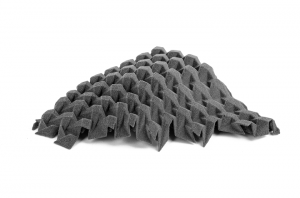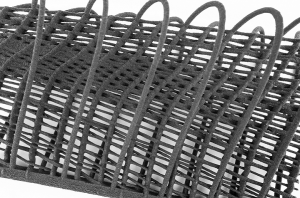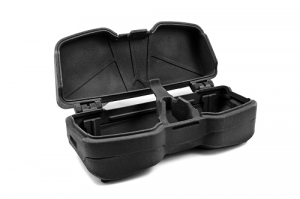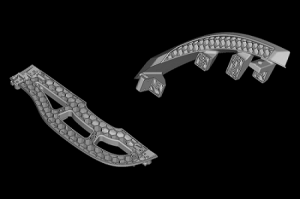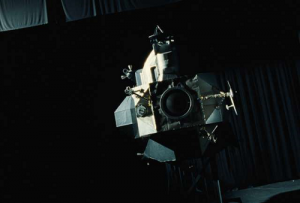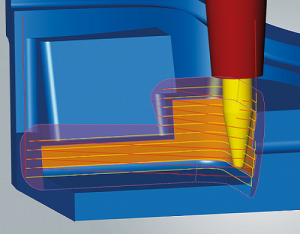Sinterit’s SLS 3D Printing and Flexible Materials Used to Make Strong Textiles for Opera Costumes
Engineering, textiles, and additive manufacturing are different industries with different growth patterns, but they are connected by an important point: structures. Additionally, each of these industries have to struggle with limitations in order to build products for less money and materials and at a higher rate of speed. But rapid prototyping has changed how these things are built and opened the door to numerous new possibilities.
Selective laser sintering (SLS) 3D printing, also known as powder bed fusion, is an accurate and durable technology that, while perhaps not the fastest method in time to part, is definitely a good choice when it comes to machines that can provide repeatable results or that print batches of many things at once. It also gives users more design freedom, which is why it’s possible to 3D print materials inspired by knitting and weaving.
But engineers aren’t typically interested in textile applications, which is why the fashion industry is driving the push to reproduce flexible features through 3D printing…leading to the invention of such innovations as hexagonal shapes corresponding to hinge joints with a pivoted angle. This kind of textile structure does not have a flexible, elastic surface, but can bend under pressure and deform.
There are many applications for flexible structures in the textile world, from decorative fabrics for interior design to upholstery and scenography, which is the design and painting of theatrical scenery. Along these same lines, SLS 3D printing can be used to create flexible textiles for theatrical costumes as well, which is what Mingjing Lin and Tsai-Chun Huang – PhD candidates in Fashion and Textile research at the Royal College of Art in London – have been working on.
Lin said, “3D printing is our media to probe creative possibilities generated from merging unlike/dynamic elements, such as digital technology and craft, traditional opera and modern performance, as well as East and West.”
Two years ago, the two began working with Polish desktop SLS 3D printer manufacturer Sinterit on creating costumes for Beijing Opera performances of “Farewell My Concubine.” Lin’s specialty is 3D printing, while Huang’s is in pleating, and the two were challenged to create 3D printed costumes that were both sustainable and flexible.
These couldn’t be just any costumes – in this opera, the costumes are an extremely important part of the performance, and had to be utterly amazing. The material used for the costumes needed to fulfill two functions: successfully create and hold the shape that the artist designed, while also being wearable enough that the performers could move freely about the stage. Clearly, this was no job for sewing mere materials like silk and cotton: 3D printing was needed to create more “dramatic geometry,” as Sinterit put it.
For this daunting task, Lin and Huang used the company’s Lisa 3D printer and special Flexa TPU material, which comes in Black, Soft, and Bright for use in various applications. Flexa is very wearable, and the costumes created with the material were able to synchronize with the performers’ bodies while at the same time retaining their shapes, which would not have been possible to achieve using more traditional materials.
The deep color of Flexa Black made it perfect for this particular opera, though Flexa Bright may be a better choice for textile fiber and costume designers, as this durable material can be dyed into different colors; Flexa Soft has the lowest hardness of the series, and is often used to design sportswear prototypes and sensory fabrics.
 Obviously, those who work in textiles can find a myriad of uses for 3D printable materials that are both strong and flexible. But here’s the thing – while I noted above that engineers aren’t typically interested in this kind of application, I also believe that it would be to their best interests if they were. Think of the kinds of products they could make with materials, like Sinterit’s Flexa, that are strong enough to hold the specific shapes that are needed for different applications but are also flexible enough to bend and deform under pressure and then spring back into position. But maybe I’m not the best judge – does anyone out there know of any engineering-related applications that are using flexible textiles? Let us know!
Obviously, those who work in textiles can find a myriad of uses for 3D printable materials that are both strong and flexible. But here’s the thing – while I noted above that engineers aren’t typically interested in this kind of application, I also believe that it would be to their best interests if they were. Think of the kinds of products they could make with materials, like Sinterit’s Flexa, that are strong enough to hold the specific shapes that are needed for different applications but are also flexible enough to bend and deform under pressure and then spring back into position. But maybe I’m not the best judge – does anyone out there know of any engineering-related applications that are using flexible textiles? Let us know!
Discuss this story and other 3D printing topics at 3DPrintBoard.com or share your thoughts in the Facebook comments below.
How long do you need to wait for a desktop SLS 3D printer?
3D Printing Industry Review of the Year May 2018
Summing up Additive Manufacturing in 2018
3D Printing News Briefs: December 19, 2018
In today’s 3D Printing News Briefs, a maker has published a free 3D print management app in the Play Store, while Formlabs works to continue accelerating its growth in the Asia Pacific region. America Makes has announced the winners of two Directed Project Opportunities, and a chemist employed by Sinterit has won a prestigious award. Finally, an engineer with a thirst for vengeance used 3D printing and a lot of glitter to get back at the people who steal packages from his porch.
Free 3D Printing App for Filament Management
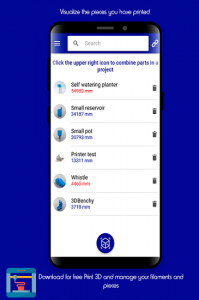 A new app, simply called 3D Print, is now available to download for free on the Google Play Store. The app was published by a maker who goes by paratiDev on Google Play, and was developed to help other makers better manage their filament.
A new app, simply called 3D Print, is now available to download for free on the Google Play Store. The app was published by a maker who goes by paratiDev on Google Play, and was developed to help other makers better manage their filament.
“It has happened to all of us, you want to print a piece and not to know for sure if you have enough filament in the coil to print it. If you have only one coil of that filament, you have only two options; you can use another filament that has more quantity or risk and print it,” paratiDev writes.
“In the first case it forces you to use another filament different from the one you wanted while in the second case you run the risk that there is not enough filament and the piece remains halfway, assuming a loss of money, filament and time.”
The app allows users to visualize how much filament they have left, view the history of 3D printed pieces they’ve made, and can also generate invoices and quotations for 3D prints. The free 3D Print app also allows you to create projects that group together several pieces, and will visualize the wight and total cost of the project.
Formlabs Continues to Grow in APAC Region
 Today, Formlabs announced that its growth in the APAC region is continuing to speed up. The company, which first entered the China market in 2015, is planning to open its new APAC headquarters in Singapore soon, and has also completed a new warehouse in Shenzhen, China for more efficient processing and shipping. While its physical presence in the region is growing, so too is its headcount: Formlabs also announced that David Tan, previously the APAC director of strategy and programs for Oracle Cloud Platform, Alliances & Channels, has been hired on as a new general manager for its own APAC team.
Today, Formlabs announced that its growth in the APAC region is continuing to speed up. The company, which first entered the China market in 2015, is planning to open its new APAC headquarters in Singapore soon, and has also completed a new warehouse in Shenzhen, China for more efficient processing and shipping. While its physical presence in the region is growing, so too is its headcount: Formlabs also announced that David Tan, previously the APAC director of strategy and programs for Oracle Cloud Platform, Alliances & Channels, has been hired on as a new general manager for its own APAC team.
“Formlabs has long set its sights on making 3D printing processes more accessible. Part of this strategy has been completely rethinking 3D printing technologies from the ground up. The second is bringing the technology to market,” explained Max Lobovsky, Co-Founder and CEO of Formlabs. “There is an immense amount of opportunity in Asia Pacific, we’re looking forward to what David and these new locations can do to improve our growing success in the region.”
America Makes Announces Directed Project Opportunities Winners
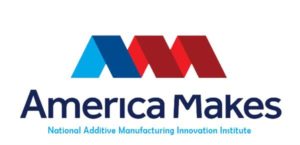 America Makes has announced the award winners of two Directed Project Opportunities, both of which were funded by the Air Force Research Laboratory (AFRL), Materials and Manufacturing Directorate, Manufacturing and Industrial Base Technology Division. The first is the acceleration of large scale additive manufacturing (ALSAM) project, with the objective of getting past the shortcomings of SLM 3D printing, and America Makes awarded $2.1 million to GE Global Research, in conjunction with GE Additive and the Applied Research Laboratory (ARL) at Penn State. With at least $525,000 in matching funds from the team, the total funding for the ALSAM Directed Project to develop an open source, multi-laser manufacturing research platform will be about $2.6 million.
America Makes has announced the award winners of two Directed Project Opportunities, both of which were funded by the Air Force Research Laboratory (AFRL), Materials and Manufacturing Directorate, Manufacturing and Industrial Base Technology Division. The first is the acceleration of large scale additive manufacturing (ALSAM) project, with the objective of getting past the shortcomings of SLM 3D printing, and America Makes awarded $2.1 million to GE Global Research, in conjunction with GE Additive and the Applied Research Laboratory (ARL) at Penn State. With at least $525,000 in matching funds from the team, the total funding for the ALSAM Directed Project to develop an open source, multi-laser manufacturing research platform will be about $2.6 million.
The second is the advancing AM post-processing techniques (AAPT) project, with a goal of improving process control and lowering costs for qualifying complex parts made with SLM technology. The first awardee is Arizona State University, in conjunction with Quintus Technologies, Phoenix Heat Treating, Inc., and Phoenix Analysis & Design Technologies, Inc., and the second is led by the ASTM International AM Center of Excellence collaborative, in conjunction with Quintus Technologies, Carpenter Technologies Corporation, Aerojet Rocketdyne, Rolls Royce Corporation, Honeywell Aerospace, GE Aviation, and Raytheon. America Makes awarded a total of $1.6 million to the two teams, which will also contribute at least $800,000 in matching funds. Both projects are expected to begin next month.
Sinterit Chemist Makes Forbes List of ’25 Under 25′ Poland
 Desktop SLS 3D printer manufacturer Sinterit is proud to announce that its chemist, Paweł Piszko, has been selected by Forbes and the Warsaw office of McKinsey & Company as one of the prestigious “25 Under 25” in Poland. There are five categories in the awards, with five winners in each, and the jury appreciated Piszko’s work on increasing the efficiency of energy collection from renewable sources. When asked by his employers what his goal was, he answered that he wanted to have “an impact on the architecture of society.”
Desktop SLS 3D printer manufacturer Sinterit is proud to announce that its chemist, Paweł Piszko, has been selected by Forbes and the Warsaw office of McKinsey & Company as one of the prestigious “25 Under 25” in Poland. There are five categories in the awards, with five winners in each, and the jury appreciated Piszko’s work on increasing the efficiency of energy collection from renewable sources. When asked by his employers what his goal was, he answered that he wanted to have “an impact on the architecture of society.”
“We are delighted that Paweł chose Sinterit as a place where he can develop his skills and check the results of his scientific activities in practice,” Sinterit wrote in a blog post. “As part of his work, he researches the chemical processes that occur during the sintering of polymers, which allows us to improve the materials that Lisa and Lisa Pro, our flagship SLS 3D printers, print from.”
3DPrint.com congratulates Paweł on this exciting achievement!
Engineer Uses 3D Printed Component to Make Glitter Bomb
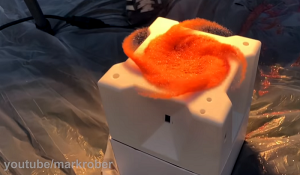 Revenge is a dish best served with glitter and fart spray…at least according to a mechanical engineer and evil genius Mark Rober. He spent nine years working at NASA’s JPL – mostly on the Curiosity Rover – and later founded a company called Digital Dudz. He was upset when someone stole a delivered package right off of his porch, and decided to employ all kinds of technology to take revenge.
Revenge is a dish best served with glitter and fart spray…at least according to a mechanical engineer and evil genius Mark Rober. He spent nine years working at NASA’s JPL – mostly on the Curiosity Rover – and later founded a company called Digital Dudz. He was upset when someone stole a delivered package right off of his porch, and decided to employ all kinds of technology to take revenge.
“I just felt like something needs to be done to take a stand against dishonest punks like this,” Rober said in his YouTube video.
“I spent nine years designing hardware that’s currently roving around on another freaking planet. If anyone was going to make a revenge bait package and over-engineer the crap out of it, it was going to be me.”
Over the course of several months, Rober sketched his idea out, then finished it in CAD before getting to work on the physical prototypes. The package contains a 3D printed component that’s contoured in such a way that four hidden phones inside can capture package thieves opening the box and getting hit with a giant cloud of colorful glitter and continuous blasts of fart spray. Check out his video below to see how things turned out, though be warned that there is some bleeped out profanity. To learn more about the details of his build, check out his friend Sean’s video as well.
Discuss these stories and other 3D printing topics at 3DPrintBoard.com or share your thoughts below.
Preview: Formnext 2018 3D printer hardware, software and material releases
3D Printing News Briefs: October 20, 2018
We’re starting with some information about a couple of upcoming shows in today’s 3D Printing News Briefs, followed by some business and aerospace news. Sinterit is bringing its newly launched material to formnext, while Materialise has announced what products it will be presenting. Registration is now open for AMUG’s 2019 Education and Training Conference. Moving on, Sciaky sold its EBAM and EB Welding System to an aerospace parts manufacturer, while final assembly has been planned for the Airbus Racer, which features a 3D printed conformal heat exchanger. The Idaho Virtualization Lab is a leader when it comes to 3D printing dinosaurs, and the recently released movie First Man used 3D printed models during filming.
Sinterit Launches New PA11 Powder
Desktop SLS 3D printing company Sinterit has launched a new material – PA11 Onyx – which it will be bringing to formnext next month, along with its Lisa and Lisa 2 Pro 3D printers. According to Sinterit, this is first powder that’s ready for use in desktop SLS 3D printers, and it delivers excellent thermal, chemical, and abrasive resistance, along with better flexibility and impact resistance. PA11 Onyx is a high performance, lightweight, polyamide-11 bioplastic produced from plant-based renewable resources. In addition, the material also has high elongation at break, which means that durable finished products, like a military glass case and custom casings, can be opened and closed thousands of times without getting damaged.
“Our clients use a lot of electronic devices, like Raspberry Pi, that need a proper, individually made housing that can endure in unfriendly conditions. They are looking for durable materials but also require some elasticity and high-temperature resistance,” said Sinterit Co-Founder Konrad Glowacki. “PA11 Onyx delivers that.”
Come visit Sinterit at booth G41 in Hall 3.1 at formnext, November 13-16, to see its 3D printers and newly launched powders, which also include Flexa Black and Flexa Grey TPU materials.
Materialise Announces formnext Product Introductions
Speaking of formnext, 3D printing leader Materialise will also be attending the event in Frankfurt, and has just revealed what new product introductions it will be displaying at its booth C48 in Hall 3. Some of the highlights include new plastic and metal materials, like Inconel, Polypropylene, and Taurus, automotive applications, and the Materialise Magics 3D Print Suite; this last includes a new Simulation Module, the E-Stage for Metal 1.1 automatic support structure generation upgrade, and Magics 23, the latest software release.
Additionally, there will also be presentations from Materialise partners and the company’s own experts, like Lieve Boeykens, the Market Innovation Manager for Materialise Software. Boeykens will be presenting on the TCT Stage about “Reducing Costs and Speeding Up the Validation of AM Parts” on November 15 at 4 pm. Visit the Materialise formnext site for updates.
AMUG Conference Registration Open
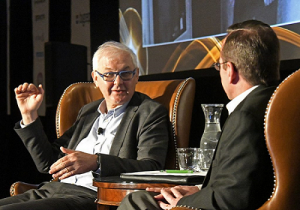 The Additive Manufacturing Users Group (AMUG) just announced that online registration is now open for its 2019 Education & Training Conference, which is now in its 31st year and will be held in Chicago from March 31-April 4. The conference is open to owners and operators of industrial 3D printing technologies for professional purposes, and welcomes designers, educators, engineers, plant managers, supervisors, technicians, and more to share application developments, best practices, and challenges in 3D printing. The program has been adjusted to include more hands-on experiences and training, and will include workshops, technical sessions, and even a new Training Lab. There will also be networking receptions, catered meals, the two-night AMUGexpo, a Technical Competition, and the fifth annual Innovators Showcase, featuring special guest Professor Gideon Levy, consultant for Technology Turn Around.
The Additive Manufacturing Users Group (AMUG) just announced that online registration is now open for its 2019 Education & Training Conference, which is now in its 31st year and will be held in Chicago from March 31-April 4. The conference is open to owners and operators of industrial 3D printing technologies for professional purposes, and welcomes designers, educators, engineers, plant managers, supervisors, technicians, and more to share application developments, best practices, and challenges in 3D printing. The program has been adjusted to include more hands-on experiences and training, and will include workshops, technical sessions, and even a new Training Lab. There will also be networking receptions, catered meals, the two-night AMUGexpo, a Technical Competition, and the fifth annual Innovators Showcase, featuring special guest Professor Gideon Levy, consultant for Technology Turn Around.
“As the AM community evolves, so will AMUG,” said Paul Bates, the President of AMUG. “We are excited to present the new program with the goal of continuing to act on our mission of educating and advancing the uses and applications of additive manufacturing technologies.”
Sciaky Sells EBAM and EB Welding System to Asian Aerospace Parts Manufacturer
Metal 3D printing solutions provider Sciaky, Inc. has announced that an unnamed but prominent aerospace parts manufacturer in Southeast Asia has purchased its dual-purpose hybrid Electron Beam Additive Manufacturing (EBAM) and EB Welding System. The machine will be customized with special controls that allow it to quickly and easily switch from 3D printing to welding. The system will be used by the manufacturer, remaining anonymous for competitive purposes, to 3D print metal structures and weld dissimilar materials and refractory alloys for said structures, as well as for other aerospace parts. Delivery is scheduled for the second quarter of 2019.
“Sciaky is excited to work with this innovative company. This strategic vision will allow this manufacturer to reduce operating costs by combining two industry-leading technologies into a single turnkey solution,” said Scott Phillips, President and CEO of Sciaky, Inc. “No other metal 3D printing supplier can offer this kind of game-changing capability.”
Airbus Plans Final Assembly for Racer
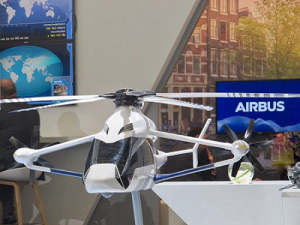
Scale model of the Airbus Racer on display at Helitech International 2018. The manufacturer is aiming for a first flight of the demonstrator in 2020. [Image: Thierry Dubois]
Together with partners of its Racer demonstration program, Airbus Helicopters explained that it definitely expects to meet performance targets, and complete the first flight of the compound helicopter on time in 2020. The 7-8 metric ton aircraft, in addition to a targeted cruise speed of 220 knots and 25% lower costs per nautical mile compared to conventional helicopters, will also feature several advanced components, including a three-meter long lateral drive shaft. Avio Aero was called in to 3D print a round, conformal heat exchanger for each later gear box, which will help achieve reduced drag.
The preliminary design review was passed last July, with final assembly targeted to begin in the fourth quarter of 2019. The flight-test program will likely be 200 flight hours, with the second part focusing on demonstrating that the Racer will be able to handle missions like search-and-rescue and emergency medical services. The program itself is part of the EU’s Clean Sky 2 joint technology initiative to help advance aviation’s environmental performance.
Idaho Virtualization Lab is 3D Printed Dinosaur Leader
 The Idaho Virtualization Laboratory (IVL), a research unit housed in the Idaho Museum of Natural History on the Idaho State University campus, has long been a leader in using 3D printing to digitize and replicate fossils and skeletons. Museum director Leif Tapanila said that IVL’s 3D printing program has been ongoing for the last 15 years, and while other labs in the country are more driven by research, the IVL is operated a little more uniquely – it’s possibly the only program in the US that goes to such great extent to 3D print fossils.
The Idaho Virtualization Laboratory (IVL), a research unit housed in the Idaho Museum of Natural History on the Idaho State University campus, has long been a leader in using 3D printing to digitize and replicate fossils and skeletons. Museum director Leif Tapanila said that IVL’s 3D printing program has been ongoing for the last 15 years, and while other labs in the country are more driven by research, the IVL is operated a little more uniquely – it’s possibly the only program in the US that goes to such great extent to 3D print fossils.
Jesse Pruitt, lab manager of the Idaho Virtualization Lab, said, “Everybody does a little bit of this and a little bit of that, but no one really does [everything we offer].
“We do our own internal research, we digitize our collections and we also do other people’s research as well.
“It’s not something you see at a smaller university. For this to exist at the level that it exists here is pretty remarkable in my mind.”
The IVL is also one of the only programs to have a large online database of the 3D models it creates, and works to spread knowledge about its 3D printing processes to students and researchers.
3D Printed Models for First Man Movie
While many movies swear by CGI to create special effects, there are some directors and production crews who still prefer to use old school miniatures and models. But old school meets new when 3D printing is used to make these models for practical effects. Oscar-winning director Damien Chazelle used some 3D printed miniature model rockets for his new movie First Man, which was just released a week ago and is all about Neil Armstrong and his legendary first walk on the moon. The movie’s miniature effects supervisor Ian Hunter, who won an Oscar for Visual Effects for Interstellar, was in charge of creating and filming the models, which included a one-thirtieth scale miniature for the giant Saturn V rocket and one-sixth scale miniatures of the Command/Service Module and Lunar Excursion Module.
“We had banks of 3D printers running day and night, running off pieces. We also used a lot of laser-cut pieces,” Hunter said about the Saturn V rocket miniature. “The tube-like shape of the rocket came from PVC piping, with the gantry made of acrylic tubing, along with many 3D printed and laser cut parts.”
The 3D printed model of the Saturn V rocket even made it into one of the trailers for the film, and the film itself.
Discuss these stories and other 3D printing topics at 3DPrintBoard.com or share your thoughts in the Facebook comments below.
Sinterit introduces first PA11 for desktop SLS 3D printing
3D Printing News Briefs: July 27, 2018
We’ve got plenty of awards and other business news for you today in 3D Printing News Briefs. Sinterit and ViscoTec each received awards for their technology, while Arkema announced that it is opening a 3D Printing Center of Excellence at its Pennsylvania facility. Vectary and Sketchfab are integrating, and Xometry is now offering SLA 3D printing. Finally, OPEN MIND Technologies has introduced its latest hyperMILL CAM software.
Sinterit Lisa Receives Award from All3DP
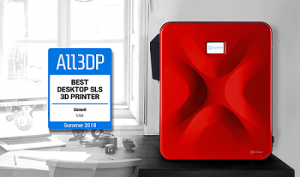 Sinterit, one of the fastest growing manufacturers of SLS 3D printers, just received the “Best Desktop SLS 3D Printer Summer 2018” award for its Lisa 3D printer by All3DP. The award shows that the company is moving in the right direction, and confirms that the Lisa is the perfect choice for 3D printing professionals looking to upgrade to SLS technology without breaking the bank. Even better for Sinterit: the award was announced in the final week of a pre-order period for its upgraded Lisa model, which will feature better hardware, bigger 3D prints, and easier maintenance.
Sinterit, one of the fastest growing manufacturers of SLS 3D printers, just received the “Best Desktop SLS 3D Printer Summer 2018” award for its Lisa 3D printer by All3DP. The award shows that the company is moving in the right direction, and confirms that the Lisa is the perfect choice for 3D printing professionals looking to upgrade to SLS technology without breaking the bank. Even better for Sinterit: the award was announced in the final week of a pre-order period for its upgraded Lisa model, which will feature better hardware, bigger 3D prints, and easier maintenance.
“All3DP is happy to present the Sinterit Lisa with the award for Best Desktop SLS 3D Printer on the market. We recognize the Sinterit team for their tremendous work in making SLS 3D printing technology more affordable and accessible,” said Tyler Koslow, Editor at All3DP. “Additionally, their recent update to the Sinterit Lisa and development of the new Sinterit Lisa 2 PRO suggests that they will remain a market leader for a long time.”
ViscoTec Awarded Special Title Two Years Running
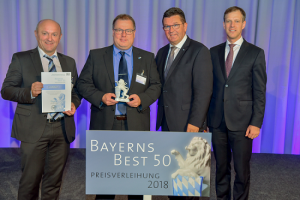
Georg Senftl (holding certificate) and Martin Stadler (holding lion) accepted the award on behalf of all ViscoTec employees.
For the second year in a row, German company ViscoTec, which specializes in pump and dose technology and has 3D printing viscous liquid products for silicone and other materials was awarded the “Bayern’s Best 50” title. For 17 years, the Bavarian Ministry of Economic Affairs has honored the 50 most dynamic, medium-sized companies in Bavaria, and the jury considers criteria such as number of employees, turnover, and social and economic contributions. ViscoTec, and the other 49 winning companies were personally awarded the title, a certificate, and a Bavarian porcelain lion by Bavaria’s Minister of Economic Affairs, Energy and Technology Franz Josef Pschierer at a recent event in Schleißheim Castle.
“Our employees all over the world actively help us to be such a successful company every day and that we will continue to develop very well in the future. Special thanks also go to our partners and customers. Their partnership with ViscoTec is constantly driving us forward. This motivates us not to stand still, to open up new possibilities and to find solutions for the daily challenges,” said Georg Senftl, Commercial Director of ViscoTec Pumpen- u. Dosiertechnik GmbH. “Last but not least, the innovative climate in the Inn-Salzach region contributes to the continuous development of companies like ViscoTec.”
Arkema to Open 3D Printing Center of Excellence
This Monday, July 30th, speciality chemical and advanced materials developer Arkema will be holding the grand opening for its new 3D Printing Center of Excellence. The center will be located at the Exton, Pennsylvania facility of its Sartomer subsidiary, which designs engineered resins for UV-curable additive manufacturing under its N3xtDimension brand. The 3D Printing Center of Excellence will work to advance 3D printing resins technology and be home to most UV-based 3D printing technologies, such as Digital Light Processing (DLP), stereolithography (SLA), and HP’s Multi Jet Fusion (MJF). It will offer a collaborative space for developing custom resins, and complete the company’s worldwide R&D network, which is dedicated to developing advanced 3D printing materials.
“Sartomer is a historic partner for 3D printing pioneers. We’re launching the 3D Printing Center of Excellence to deepen our support of the visionaries working to develop innovative 3D printed materials,” said Sumeet Jain, Global Director, 3D Printing at Sartomer.
Vectary Integrates Sketchfab
 Online 3D design tool Vectary is giving its users access to thousands of new 3D models, as it has now integrated Sketchfab, the world’s largest platform for interactive 3D content. Vectary users can connect to the Sketchfab library and import hundreds of thousands of 3D models with one click, as well as export, publish, and even sell their own 3D work on Sketchfab. Vectary CEO Michal Koor, who co-founded the tool in 2014 with Pavol Sovis said, “Easily importing Sketchfab 3D models in the Vectary 3D tool can be a great way to create design concepts and bring more inspiration to their work. Exporting their Vectary models to Sketchfab gets them exposure to a larger audience, which can mean an increased customer base and new income possibilities by selling their work on one of the best 3D marketplaces available.”
Online 3D design tool Vectary is giving its users access to thousands of new 3D models, as it has now integrated Sketchfab, the world’s largest platform for interactive 3D content. Vectary users can connect to the Sketchfab library and import hundreds of thousands of 3D models with one click, as well as export, publish, and even sell their own 3D work on Sketchfab. Vectary CEO Michal Koor, who co-founded the tool in 2014 with Pavol Sovis said, “Easily importing Sketchfab 3D models in the Vectary 3D tool can be a great way to create design concepts and bring more inspiration to their work. Exporting their Vectary models to Sketchfab gets them exposure to a larger audience, which can mean an increased customer base and new income possibilities by selling their work on one of the best 3D marketplaces available.”
Xometry Adds SLA 3D Printing to List of Services
 3D printing service provider Xometry has added stereolithography (SLA) 3D printing to the list of 3D printing processes it provides. Versatile SLA technology offers higher resolution 3D printing, which will allow Xometry’s customers to achieve prints with good surface finish and fine detail – perfect for production parts and prototypes. The technology also enables you to print large products and parts and can create complex parts, to meet tolerances of +/- 0.004” or +/- 0.001” per inch, in a single operation.
3D printing service provider Xometry has added stereolithography (SLA) 3D printing to the list of 3D printing processes it provides. Versatile SLA technology offers higher resolution 3D printing, which will allow Xometry’s customers to achieve prints with good surface finish and fine detail – perfect for production parts and prototypes. The technology also enables you to print large products and parts and can create complex parts, to meet tolerances of +/- 0.004” or +/- 0.001” per inch, in a single operation.
Xometry also offers plenty of SLA-friendly materials, such as the Accura and Somos brands. Try it out today – upload your 3D CAD file to Xometry now to get an instant SLA quote.
New Version of hyperMILL CAM Software Released
Germany CAD/CAM software solutions develop OPEN MIND Technologies AG has released the latest version of its advanced CAM software, hyperMILL 2018.2, which provides more machining efficiency and several new enhancements and features. 3D Z-level Shape Finishing, available in the hyperCAD -S module, now comes with automatic face extension to automatically extend selected milling surfaces during CAM programming, and can now also support conical barrel cutters.
This version also provides a “V sketch” command, which allows users to make easy changes to turning contours and milling boundaries by assigning geometric constraints to 2D contours. Other enhancements to the -S module include being able to measure and record distances between two shapes, like meshes, solids, and face models.
Alan Levine, Managing Director of OPEN MIND Technologies USA, Inc., said, “Keeping the hyperMILL suite at the forefront of CAM technology, we are pleased to offer our customers improved CAM strategies and enhanced CAD tools for even greater machining productivity through our new release of hyperMILL 2018.2.”
Discuss these stories and other 3D printing topics at 3DPrintBoard.com or share your thoughts in the Facebook comments below.

